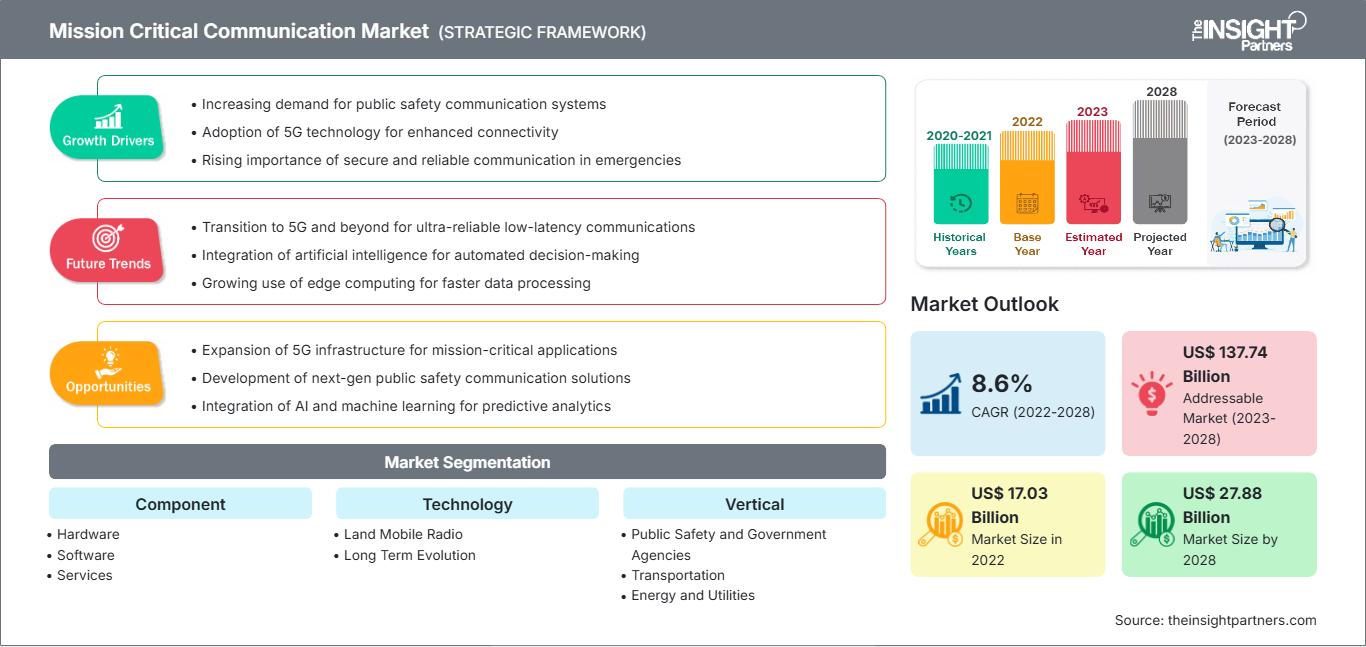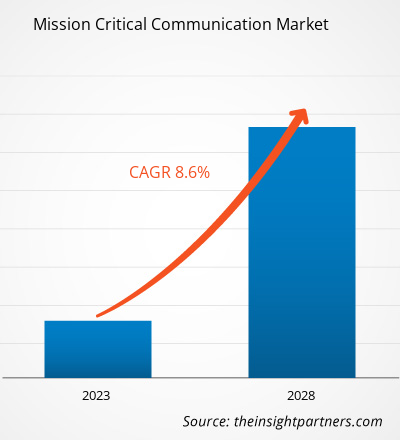Der Markt für unternehmenskritische Kommunikation soll von 17.031,56 Millionen US-Dollar im Jahr 2022 auf 27.876,68 Millionen US-Dollar im Jahr 2028 wachsen; von 2022 bis 2028 wird mit einer durchschnittlichen jährlichen Wachstumsrate von 8,6 % gerechnet.
Unternehmenskritische Kommunikation bietet Kommunikationsmethoden, wenn herkömmliche Netzwerke den Anforderungen nicht mehr gerecht werden. Dies ist häufig bei großen öffentlichen Veranstaltungen der Fall, da Tausende von Mobilfunknutzern das Netzwerk gleichzeitig nutzen und die meisten öffentlichen Kommunikationsnetzwerke einer solchen Intensität nicht standhalten können, ohne zusammenzubrechen. Herkömmliche Mobilfunknetze fallen auch in Katastrophengebieten oder bei öffentlichen Sicherheitskrisen aus, sodass die Ersthelfer vor Ort ohne Kommunikationssysteme dastehen. Unternehmenskritische Kommunikation ist auch in der Öl- und Gasindustrie wichtig. Gassektor, Küstenwache, Heimatschutz, Transportindustrie, unbemannte Fahrzeuge und mehr.
Eine Zunahme von Terrorismus, Grenzspannungen, Naturkatastrophen, symmetrischer Kriegsführung und Aufständen; grenzüberschreitende Kommunikation in schweren Notfällen; beschädigte Kommunikationsinfrastrukturen; verschiedene sicherheitskritische Aufgaben wie Hebevorgänge, das Betreten enger Räume und Notfallmaßnahmen; die Notwendigkeit der Koordination zwischen verschiedenen Parteien – der Bedarf an unternehmenskritischer Kommunikation wird steigen. Darüber hinaus bieten unternehmenskritische Netzwerk- und Infrastruktursysteme bessere Breitbandkonnektivität, Mobilität, Interoperabilität und Sicherheit.
Passen Sie diesen Bericht Ihren Anforderungen an
Sie erhalten kostenlos Anpassungen an jedem Bericht, einschließlich Teilen dieses Berichts oder einer Analyse auf Länderebene, eines Excel-Datenpakets sowie tolle Angebote und Rabatte für Start-ups und Universitäten.
Markt für unternehmenskritische Kommunikation: Strategische Einblicke

- Holen Sie sich die wichtigsten Markttrends aus diesem Bericht.Dieses KOSTENLOSE Beispiel umfasst Datenanalysen, die von Markttrends bis hin zu Schätzungen und Prognosen reichen.
Sie erhalten kostenlos Anpassungen an jedem Bericht, einschließlich Teilen dieses Berichts oder einer Analyse auf Länderebene, eines Excel-Datenpakets sowie tolle Angebote und Rabatte für Start-ups und Universitäten.
Markt für unternehmenskritische Kommunikation: Strategische Einblicke

- Holen Sie sich die wichtigsten Markttrends aus diesem Bericht.Dieses KOSTENLOSE Beispiel umfasst Datenanalysen, die von Markttrends bis hin zu Schätzungen und Prognosen reichen.
Auswirkungen der COVID-19-Pandemie auf den Markt für unternehmenskritische Kommunikation
Die COVID-19-Pandemie bremste das Wachstum des Marktes für unternehmenskritische Kommunikation aufgrund von Unterbrechungen der Lieferkette und Einschränkungen des internationalen Handels während der Pandemie. Die ungünstigen Bedingungen für wirtschaftliche Aktivitäten führten zu einem kurzen Produktionsstopp an wichtigen Produktionsstandorten für unternehmenskritische Kommunikationshardware. Infolgedessen richteten mehrere große Komponentenlieferanten und Technologieanbieter ihren Fokus auf Kostensenkungen und die Reduzierung der Produktionsaktivitäten. Aufgrund der ununterbrochenen Nachfrage nach Elektronik könnten Unternehmen im wachsenden Markt für unternehmenskritische Kommunikation jedoch während der Erholungsphase 2021 ihren Betrieb wieder aufnehmen.
Markteinblicke – Markt für unternehmenskritische Kommunikation
Der Markt für unternehmenskritische Kommunikation ist geografisch in Nordamerika, Europa, Asien-Pazifik (APAC), Naher Osten und Afrika (MEA) sowie Südamerika (SAM) unterteilt. Europa hatte 2021 den größten Marktanteil, während der asiatisch-pazifische Raum im Prognosezeitraum voraussichtlich die höchste durchschnittliche jährliche Wachstumsrate verzeichnen wird.
Laut der Agentur der Europäischen Union stieg die Zahl der Cyberangriffe von 432 im Jahr 2019 auf 756 im Jahr 2020. Missionskritische Kommunikationssysteme spielen eine entscheidende Rolle bei der Erkennung und Verhinderung von Cyberangriffen. BroadNet – der Europäische Plan für die öffentliche Sicherheit – konzentriert sich auf die Einführung sicherer, missionskritischer Breitbandkommunikation, die von entfernten Standorten aus betrieben werden kann, um die Sicherheit in allen Ländern zu gewährleisten. Daher dürften die zunehmenden Sicherheitsbedrohungen durch die zunehmende Zahl von Cyberangriffen und Regierungsinitiativen zur Einführung fortschrittlicher Kommunikationslösungen für Sicherheitszwecke in den kommenden Jahren lukrative Möglichkeiten für den Marktanteil missionskritischer Kommunikation in Europa schaffen.
In Europa investieren Länder wie Schweden, die Niederlande und die Schweiz massiv in den Ausbau von Kraftwerken, um ihren CO2-Fußabdruck zu reduzieren. Diese Faktoren tragen zusätzlich zum Wachstum des Marktes bei. Darüber hinaus wird erwartet, dass die Einführung neuer Produkte in der Region das Wachstum des Marktes für missionskritische Kommunikation weiter vorantreibt. So haben Nokia und Nordic Telecom im April 2019 im kürzlich eröffneten 410–430-MHz-Band das weltweit erste LTE-Netz für Mission Critical Communication (MCC) aufgebaut. Der tschechische Betreiber Nordic Telecom kann dank Nokias hochmoderner und zukunftssicherer mobiler Breitbandlösung, die neue Dienste ermöglicht, die nur über mobile Breitbandnetze erreichbar sind, die öffentliche Sicherheit und Katastrophenhilfe beschleunigen. Die industrielle Entwicklung in den genannten Ländern wird das Wachstum des Marktes für missionskritische Kommunikation vorantreiben.
Technologiebasierte Erkenntnisse
Technologischer Hinsicht ist der Markt für missionskritische Kommunikation in Land Mobile Radio und LTE unterteilt. Das LTE-Segment hatte 2021 einen größeren Marktanteil im Bereich der missionskritischen Kommunikation. LTE ist ein 4G-Mobilfunkstandard, der die Netzwerkkapazität und -geschwindigkeit für Mobiltelefone und andere Mobilgeräte verbessert. Neben geringerer Latenz und erweiterbarer Bandbreitenkapazität ist es abwärtskompatibel mit dem bestehenden globalen System für mobile Kommunikation und universellen mobilen Telekommunikationsdiensttechnologien.
Der Markt für unternehmenskritische Kommunikation wurde nach Komponente, Technologie, Branche und Geografie segmentiert. Nach Komponente ist der Markt für unternehmenskritische Kommunikation in Hardware, Software und Dienste segmentiert. Nach Technologie ist die Marktanalyse in LTE und Land Mobile Radio unterteilt. Nach Branche ist die Marktanalyse in öffentliche Sicherheit und Behörden, Transport, Energie und Versorgung, Bergbau und Sonstiges kategorisiert. Nach Geografie ist der Markt hauptsächlich in Nordamerika, Europa, Asien-Pazifik (APAC), Naher Osten und Afrika (MEA) und Südamerika segmentiert.
Telefonaktiebolaget LM Ericsson; Thales Group; Motorola Solutions; L3Harris Technologies, Inc.; und Hytera Communications Corporation Ltd. sind einige der führenden Marktteilnehmer. Der Markt für unternehmenskritische Kommunikation ist stark fragmentiert, da mehrere Akteure in einer bestimmten Region ansässig sind und sich daher auf die Befriedigung der inländischen Nachfrage konzentrieren.
Markt für unternehmenskritische Kommunikation
Die Analysten von The Insight Partners haben die regionalen Trends und Faktoren, die den Markt für unternehmenskritische Kommunikation im Prognosezeitraum beeinflussen, ausführlich erläutert. In diesem Abschnitt werden auch die Marktsegmente und die geografische Lage in Nordamerika, Europa, dem asiatisch-pazifischen Raum, dem Nahen Osten und Afrika sowie Süd- und Mittelamerika erörtert.Umfang des Marktberichts zur unternehmenskritischen Kommunikation
| Berichtsattribut | Einzelheiten |
|---|---|
| Marktgröße in 2022 | US$ 17.03 Billion |
| Marktgröße nach 2028 | US$ 27.88 Billion |
| Globale CAGR (2022 - 2028) | 8.6% |
| Historische Daten | 2020-2021 |
| Prognosezeitraum | 2023-2028 |
| Abgedeckte Segmente |
By Komponente
|
| Abgedeckte Regionen und Länder | Nordamerika
|
| Marktführer und wichtige Unternehmensprofile |
|
Dichte der Marktteilnehmer für unternehmenskritische Kommunikation: Verständnis ihrer Auswirkungen auf die Geschäftsdynamik
Der Markt für unternehmenskritische Kommunikation wächst rasant. Dies wird durch die steigende Endverbrauchernachfrage aufgrund veränderter Verbraucherpräferenzen, technologischer Fortschritte und eines stärkeren Bewusstseins für die Produktvorteile vorangetrieben. Mit der steigenden Nachfrage erweitern Unternehmen ihr Angebot, entwickeln Innovationen, um den Bedürfnissen der Verbraucher gerecht zu werden, und nutzen neue Trends, was das Marktwachstum weiter ankurbelt.

- Holen Sie sich die Markt für unternehmenskritische Kommunikation Übersicht der wichtigsten Akteure
Die Akteure auf dem Markt für unternehmenskritische Kommunikation konzentrieren sich hauptsächlich auf die Entwicklung fortschrittlicher und effizienter Produkte.
- Im Jahr 2022 kündigte L3Harris Technologies auf der International Wireless Communications Expo (IWCE) den Mission Critical Push-to-Talk (MCPTT)-Standard für 15 seiner Funkgeräte der XL-Reihe an. MCPTT wird in den Geräten der XL-Serie ausgestellt, die landesweite Interoperabilität mit Feuerwehr, Polizei und Rettungsdiensten ermöglichen.
- Im Jahr 2022 veranstaltete Hytera, ein weltweit führendes Unternehmen für professionelle Kommunikationstechnologien und -lösungen, eine Online-Auftaktveranstaltung, um seine Untersuchungen und Erkenntnisse zur unternehmenskritischen Kommunikation der nächsten Generation vorzustellen. Mit der Veröffentlichung des Whitepapers „Convergence-Native Next-Gen Mission-Critical Networks“ und mehrerer Produktportfolios ist das Unternehmen in der Lage, eine neue „Hybrid“-Ära für die unternehmenskritische Branche einzuläuten.
- Im Jahr 2021 gaben CTS und TASSTA, der in Deutschland ansässige Pionier für unternehmenskritische Kommunikation über drahtlose Netzwerke, eine neue strategische Allianz bekannt, die die privaten 4G LTE- und 5G-Mobilfunknetze von CTS, die im CBRS-Spektrum laufen, mit der unternehmenskritischen Push-to-Talk-Kommunikationslösung von TASSTA kombiniert.
- Historische Analyse (2 Jahre), Basisjahr, Prognose (7 Jahre) mit CAGR
- PEST- und SWOT-Analyse
- Marktgröße Wert/Volumen – Global, Regional, Land
- Branchen- und Wettbewerbslandschaft
- Excel-Datensatz
Aktuelle Berichte
Verwandte Berichte
Erfahrungsberichte
Grund zum Kauf
- Fundierte Entscheidungsfindung
- Marktdynamik verstehen
- Wettbewerbsanalyse
- Kundeneinblicke
- Marktprognosen
- Risikominimierung
- Strategische Planung
- Investitionsbegründung
- Identifizierung neuer Märkte
- Verbesserung von Marketingstrategien
- Steigerung der Betriebseffizienz
- Anpassung an regulatorische Trends




















 Kostenlose Probe anfordern für - Markt für unternehmenskritische Kommunikation
Kostenlose Probe anfordern für - Markt für unternehmenskritische Kommunikation